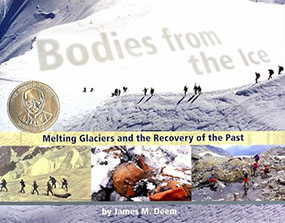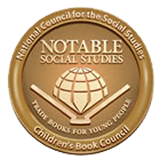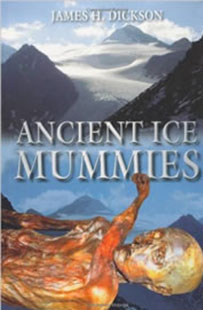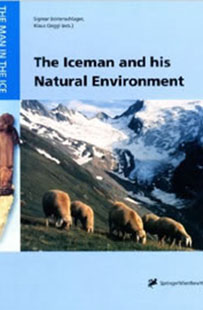|
Hardcover edition, 2008.
|
~~ Information about Otzi ~~ ~~ Related Books by James M Deem: Bodies from the Ash ~~ Bodies from the Bog ~~ |
Bodies from the Ice: Melting Glaciers and the Recovery of the Past tells the story of Earth's melting alpine glaciers and the recent archaeological discoveries made there.
 In 1991 a husband and wife climbing a mountain in northern Italy stumbled across what appeared to be trash left by careless hikers. On closer inspection they realized that it was a human corpse lying near the surface of a melting alpine glacier. Ultimately, scientific study revealed that the man had lived 5,300 years earlier. Now known as , he is one of the most important archaeological discoveries ever made.
In 1991 a husband and wife climbing a mountain in northern Italy stumbled across what appeared to be trash left by careless hikers. On closer inspection they realized that it was a human corpse lying near the surface of a melting alpine glacier. Ultimately, scientific study revealed that the man had lived 5,300 years earlier. Now known as , he is one of the most important archaeological discoveries ever made.
All around the world, from South America’s Andes Mountains to the European Alps to Asia’s Himalayas, glaciers are rapidly melting. Their disappearing ice uncovers not only the rocky terrain that has lain beneath for thousands of years, but also the long-hidden bodies of people who died in the glaciers. They may have been hunters, soldiers, shepherds, mountain climbers, dairymaids, or unfortunate travelers, and sometimes children. As their bodies are revealed, scientists study them to learn more information about the earth’s past. But what will happen if our grinding, gliding glaciers disappear altogether?
With sweeping mountain vistas, vintage images of early climbers, and a quiet respect for the lives that are being uncovered and studied by scientists all over the world, acclaimed author James M. Deem takes the reader on an icy and epic adventure. He uncovers the magic lore of glaciers themselves, sharing stories of pioneering female climbers and early Mount Everest enthusiasts, and even stories of the glaciers themselves, at one point considered to be a creation of the devil devised to punish sinners, full of dragons and witches . . .
Honors and Reviews
 Kirkus Reviews
Kirkus Reviews 
(starred review)
"With global warming, the glaciers that crown our highest mountains have retreated, revealing humans who died there long ago. This respectful photo-essay opens with the story of Ötzi, found in the Alps in 1991 more than 5,000 years after his death. Deem goes on to explain how glaciers work to preserve and destroy human remains and to provide some historical background. Looking beyond Europe, he describes Inca children sacrificed on high Andean peaks, the discovery of the body of George Mallory, who died on Mt. Everest in 1924, and a man who died between 1670 and 1850 in what is now northern British Columbia whose DNA revealed connections to present-day First Nations Canadians. Clearly identified lithographs, paintings and archival photos help readers see how much has changed in these high altitudes, while maps make clear the locations of particular discoveries. Photos of skulls, mummified bodies and artifacts will fascinate readers. An intriguing read, complementing the author’s highly commended Bodies from the Bog (1998) and Bodies from the Ash (2005), with a bonus environmental message...."
Chicago Tribune
Bodies from the Ice...gives us ...puzzles and various people trying to solve them. How did the bodies—spread out over continents and from a roughly 5,000-year time span—come to be where they are? The bodies include some who died in violent combat, while others, like the Incan children from the Andes, represent willing sacrifices made by a culture. Uniting these bodies is the book's real subtext, glaciers. The book becomes an exploration of two different kinds of science in the field. First, we're shown the ethical, mechanical and political problems that can follow the discoveries of these bodies. Who, for example, is given the privilege of naming the individual? (Don't miss the tale of "Long Ago Person Found" from British Columbia.) Second, there is the larger science of climate and the ways in which glaciers over time—advancing or retreating—must interest us all. The book starts specific and local and grows gradually into a story that is multiple and global. Illustrations here are largely photographic and sometimes startle with their realism, as in the faces of those Incan sacrificial children.... [S]cientific workers in Bodies from the Ice are in the foreground, diverse and action-oriented. This is scientific life in the field, and the book does a good job of making clear why those jobs should matter to the rest of us. Realities underneath our own skins or far away and long ago can all become exciting paths for curiosity."
Booklist
"There are books about melting glaciers and books about frozen bodies, but this attractive offering combines the topics in a way that will intrigue readers. It begins with a chance discovery by walkers in northern Italy who find a thawing corpse originally thought to be from the 1800s. Scientists later realized the body was more than 5,000 years old. As glaciers melt throughout the world, more frozen bodies are appearing, adding greatly to the knowledge researchers have about history and culture. Individual chapters cover types of glaciers and why they are fertile territory for housing bodies; the Chamonix glacier, which saw women climbers in the early 1800s; and the mystery of George Mallory, who died trying to climb Mt. Everest. Perhaps most fascinating to kids will be the chapter on recently discovered Incan children sacrificed to the gods. The pictures of these children, looking as though they might be sleeping, are arresting. Heavily illustrated with historical memorabilia as well as photos of bodies, scenery, artifacts, and rather simplistic maps..."
School Library Journal, "Conversations with Dead People"
"....compelling, down to its very marrow...is James Deem’s Bodies from the Ice: Melting Glaciers and the Recovery of the Past.... Global warming may be a problem, but it can also present an opportunity. When glaciers melt, things appear—like human bodies. In the early 1990s, two German tourists were mountain climbing in the Ötzal Alps between Austria and Italy. The weather was warm, and they discovered a body in the thawing ice. It didn’t take the police long to realize that this was not a recently dead body. The clothing was strange. An unusual ax lay nearby. In fact, the body was over 5,300 years old! The iceman was nicknamed Ötzi (rhymes with Tootsie). Your audience might have some theories about how the iceman arrived at his final destination. Deem also examines the mummified bodies of children found in the Andes mountains, and the body of a man named George Mallory who tried to climb Mount Everest in 1924, and then vanished. Experts wondered for years whether Mallory made it to the top before he presumably fell to his death; if his body could ever be found, the mystery would be solved. Well, he was, but the mystery wasn’t...."
Science
"Preserved bodies frozen in ice present one aspect of human history that few people, other than a small number of specialists, ever glimpse. Deem has compiled a highly useful and readable book on that unusual aspect of prehistory. He pulls together detailed and well-illustrated accounts of the scientific investigation of such discoveries as the iceman Ötzi, the remains of frozen children in the Peruvian Andes, and the body of George Mallory on Mount Everest. In addition, he provides a clear discussion of glaciology and how prehistoric events can be preserved. The short book accurately portrays the process of science from discovery to investigation."
Science Books and Films
"In Bodies from the Ice, author James Deem has compiled a highly useful and readable volume on a unique aspect of human history and prehistory.... In addition, the author provides a clear discussion of the science of glaciology (the study of glaciers) and how events in prehistory can be preserved. He concludes with a chapter on the scientific importance of the human past in relation to glaciers, and the ever-present threat of losing more of the world’s glaciers as climates continue to change. The book is small, but accurately portrays the process of science from discovery to investigation. A general audience would benefit from reading it, and it is appropriate as well for junior high and high school audiences. The book could also be used for classroom discussions pertaining to global environmental change, history, prehistory, and scientific inquiry."
 School Library Journal
School Library Journal 
(starred review)
"Deem’s lucid account explores mummified remains recovered from several glacial locations and time periods. The many discoveries presented include the famous 5300-year-old Alpine Iceman Ötzi, the mummified Incan children of the Andes Mountains, and the identification of George Mallory’s body on Mount Everest. The background and methodology of glaciology are examined, as are relevant issues in climate change and archaeology; historical photographs of glaciers are compared to modern photographs of the same, much-receded ice. Full-color photographs, reproductions, and maps are clearly captioned; grand images of glaciated mountain peaks span entire pages, and detailed pictures of recovered objects, including the mummies themselves, the Iceman’s ax, and surviving fabric fragments are presented. To nitpick one point, Deem states that scientists "don’t understand" why the Ice Age glaciers retreated, instead of mentioning the Milankovitch cycles as a consensus explanation. Nonetheless, this volume provides updated information, including new insights into the causes of the Iceman Ötzi’s death. With its extensive bibliography, suggested Web sites, and a listing of glaciers to visit, Bodies is a fantastic resource. Deem superbly weaves diverse geographical settings, time periods, and climate issues into a readable work that reveals the increasing interdisciplinary dimensions of the sciences."
 Library Media Connection
Library Media Connection 
(starred review)
"This highly intriguing work takes readers on a fascinating venture into some of the most remote regions of the world, to glaciers that are revealing their hidden treasures as they melt at ever increasing speeds. Individual chapters discuss different glacier types with discussion of how they can preserve and destroy human remains, and they feature simple maps so readers can get their bearings. The author discusses what archaeologists learn about history and culture through study of the preserved bodies. Historical paintings, illustrations and archival photos are included throughout, as are full-color photos of mummified bodies, skulls, and other artifacts found in the ice, all of which will fascinate readers. Children will be especially engrossed by the chapter on the frozen children of the Andes in South America who were sacrificed to appease their gods. Vivid photos of human remains are eerie and will surely intrigue readers of all ages. This book is a treat to look at, but is also chock-full of enough text and factual information to be a great resource for research reports. A list of glaciers to visit and suggested Web sites are included. Bibliography. Index. Highly Recommended."
Bulletin of the Center for Children's Books:
"Deem seems to be turning exhumation studies into a cottage industry (in Bodies from the Ash, BCCB 12/05, etc.), and this examination of human remains uncovered by shifting glaciers boasts his signature balance of delightful shivers and solid science. Readers meet the recently deceased and the longtime goners; the victims of accident, murder, and sacrifice; corpses sought and stumbled upon; remains intact and ravaged by grinding ice. Moving quickly beyond the sensationalism of each gruesome discovery, Deem carefully considers the terrain, ice formations, and glacial movement that variously entrap and preserve, or displace and dismember human remains. Discoveries from Europe, Asia, and the Americas are covered, including such notables as mountaineer George Mallory and the Inca ice children; a plethora of color photographs features not only the bodies but also the reclamation and research activities that enhance our understanding of the past. Deem reflects on the role of global warming in the accelerated rise in discoveries, but whether that warming results from human activity or an ice-age cycle is left open to debate. Several juxtaposed photographs of snow-covered peaks turned barren over a relatively short span of years should convince readers, though, that reduce-reuse-recycle might not be such a bad idea. Index, bibliography, and a list of related websites are appended."
Horn Book
"First there was Bodies from the Bog, then Bodies from the Ash, and now Deem continues his interest in mummified bodies with Bodies from the Ice, a book that sits comfortably at the intersection of several disciplines: anthropology, archaeology, geography, glaciology, and history. After introducing the discovery of Ötzi (who, at an estimated 5,300 years, is the oldest mummified person found in ice), Deem gives his readers a brief primer on glaciers before treating them to a tour of mummified bodies found in the ice the world over (in the Alps, Andes, Himalayas, and Rockies). Glaciers—and the preserved past they offer up—give us an intriguing peek into various cultures, yielding information on everything from human sacrifice to occult superstition to sporting endeavors. As the book concludes, a striking irony becomes evident: glaciers continue to melt at an alarming rate, warranting caution and concern for the global environment, yet even as they dwindle they offer As the book concludes, a striking irony becomes evident: glaciers continue to melt at an alarming rate, warranting caution and concern for the global environment, yet even as they dwindle they offer up more clues to our human past."
Children's Literature
"The body of the iceman was found by a couple climbing in the mountains of northern Italy, near the Austrian border in 1991. It was later determined to be the body of a man who had lived about 5,300 years earlier. An Austrian newspaper named the iceman Ötzi for the Otztal Alps where the body had been found. This story will command the attention of young students, and they will learn other fascinating facts as the author explains the movement of glaciers and how over the years, many artifacts, as well as bodies, have been found as the ice shifts and melts. Many of the photographs and illustrations show the dangers that mountain climbers faced, and several of the chapters tell of climbers who perished while facing the challenges of such endeavors. The format will keep the reader interested in the ecology of the areas as well as the stories of the individuals involved. The book closes with advice on ways to help the environment and a long listing of websites for further research."







